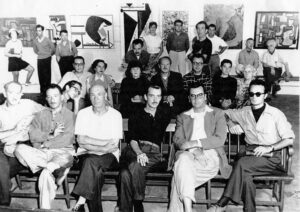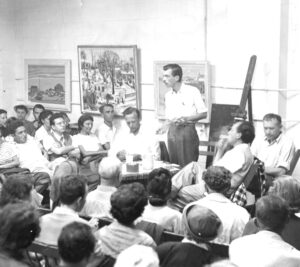Following a decade marked by the horrors of war and on the cusp of another that would secure America’s global ascendancy, Provincetown’s Forum 49 was more than an art exhibition or a series of public events in the summer of 1949. It captured a moment seized by uncertainty, in which nothing artistic, political, or intellectual seemed clear.

An “effort to relate all the arts,” according to one organizer, Forum 49 was thoroughly interdisciplinary, drawing speakers from architecture, painting, politics, law, psychoanalysis, film, music, and literature. Held in an old garage-turned-art gallery on Commercial Street, with 200 people squeezed into repurposed Central Methodist Church pews, Forum 49 would reanimate Provincetown as a cultural center. It was the germinal gathering for a group of painters soon to be known as Abstract Expressionists.
Many Forum 49 participants saw abstraction not as a stylistic choice but as the only form available to them in the wake of World War II. “No one now creates with joy; on the contrary, with anguish,” announced Robert Motherwell at an event titled “French Art Vs. U.S. Art Today.” Gyorgy Kepes, speaking on “Directions in 20th Century Architecture” a week later, said, “In this incredible chaos, we are almost lost people. We have lost our inner seismograph.”
Drawn together by what painter Adolph Gottlieb described as a “desperate attempt to escape from evil,” artists in late 1940s America demanded new aesthetic forms — forms as opaque and disoriented from convention as the reality from which they now emerged. To Gottlieb, abstraction was, ironically, “the realism of our time.”
A consensus on abstraction, however, was by no means a foregone conclusion. When Cecil Hemley, Fritz Bultman, and Weldon Kees were organizing Forum 49, controversies plagued its first assemblies. The Provincetown Art Association, under the leadership of the notoriously anti-modernist Charles Hawthorne, refused to host it, and even Donald Witherstine, whose Gallery 200 would be the Forum’s venue, forced Kees to include several traditional artists to satisfy his market’s more conservative tastes. Witherstine also limited the show’s run to a mere two weeks, prompting Kees’s wife, Anne, to describe him as “a class A son of a bitch for my money.”

While Kees resented Witherstine’s meddling, he acknowledged that abstraction was difficult for an uninitiated public. Kees ensured that the inaugural event on July 3, titled “What Is an Artist?,” included opposing views, with only two abstract painters, Gottlieb and Hans Hofmann, alongside architect Serge Chermayeff and the representational painter George Biddle. With 500 people turned away that first night, Kees was undoubtedly successful in sparking the public’s curiosity. The four talks drew a clear fault line between Biddle’s call for social realism and impassioned defenses of abstraction by Gottlieb and Hofmann.
Hofmann, the final speaker of the night, is said by art historian Jennifer Liese to have won over the crowd. He closed his lecture with a defense of modern art and democracy: “Our constitution is a great work of art; it must not be destroyed by mediocrity,” said Hofmann. “Let the youth of America speak. Let a free press and a creative critic speak. Long live the arts and the artist in a free future.”
Gottlieb and Hofmann would find themselves in opposite camps just five weeks later. Hofmann, along with Fritz Bultman, circulated a manifesto to protest “French Art Vs. U.S. Art Today,” writing: “The estate of the arts should never be narrowed to a national basis — particularly by the artists.” Bultman was incensed by the event’s premise, denouncing its “chauvinism” in his notebook and even sending Hemley and Kees his resignation (which he later withdrew).
Despite that event’s binary title, Forum 49 was overtly internationalist from the start. It championed four artists from Provincetown — Blanche Lazzell, E. Ambrose Webster, Oliver Chaffee, and Agnes Weinrich — specifically because they developed their practice in Paris under the tutelage of French Cubist painters such as Fernand Léger.
Like many other tensions arising during Forum 49, this conflict reflected a much larger controversy over American nationalism and modern art. While it was still years before Abstract Expressionism would become a vaunted American export, the U.S. government had already funded two European exhibitions of American abstraction in 1947 in the hopes, one must assume, of promoting a capitalist culture abroad. Critics like Clement Greenberg and Harold Rosenberg would also celebrate the natal Americanism of these artists — to the point, according to some, of obscuring their profound indebtedness to the European avant-garde.

It was precisely their internationalism that made abstract artists suspect to the U.S. government, the same government that would propagandize their style in the years to come. Speaking in August 1949, Sen. George Dondero of Michigan, a forerunner of Sen. Joseph McCarthy, warned the public against these “human art termites” who were “boring industriously to destroy the high standards and priceless traditions of academic art.”
Despite Soviet Russia’s embrace of Social Realism — the style espoused by Biddle on Forum 49’s opening night — it was not representational art that worried Sen. Dondero. It was art derived from the “isms” of European art — the “isms of depravity, decadence, and destruction” — that signaled a Communist threat to the American way of life. “The question is,” said Dondero, “what have we, the plain American people, done to deserve this sore affliction that has been visited upon us so direly; who has brought down this curse upon us: who has let into our homeland this horde of germ-carrying art vermin?”
Such was the paranoia of the time that Weldon Kees was forced to assuage the “hysteria” prompted by the title of Dwight Macdonald’s lecture “The Dream World of Soviet Bureaucracy” by adding the following caveat: “Speaker: Dwight Macdonald, editor of Politics, on a new theory exposing the lies of the Russian dictatorship.” But Kees’s promotion of Macdonald as a “vociferous opponent of Communism” was, in some ways, misleading. For Macdonald, this was a recent political posture, having moved from his Marxist position of less than 10 years before. And while Kees, Macdonald, and many others had protested against a Communist-backed Waldorf Conference in New York in the spring of 1949, the political landscape still revealed confusing polarities, with artists and intellectuals taking various and sometimes conflicting positions. Standing opposed to Kees and Macdonald were several others who under other circumstances would be their leftist bedfellows, including Arthur Miller, Norman Mailer, and Dorothy Parker.
Perhaps the greatest lesson of Forum 49 is the way it headed off a moment of anxious uncertainty with vibrant public debate. Forum 49 remained open to ideas across disciplines and even, to some extent, across the political spectrum. It invited not only the conservative-minded but also the former U.S. attorney general and Nuremberg trial judge Francis Biddle (brother of George Biddle) to speak on America’s responsibilities in the New World.
Rather than turn away from confounding political disparities, Forum 49 participants created a brief respite from the unsettled and often hostile atmosphere of midcentury America. Forum 49 opened a space, to borrow from Hans Hofmann’s inaugural lecture, for “all that is young, vital, progressive, and honest.” We would do well to think about how and whether such a spirit could be stirred again, on the Outer Cape, 75 years later.



